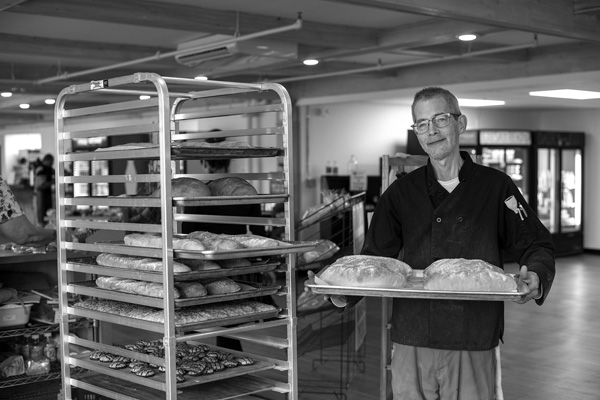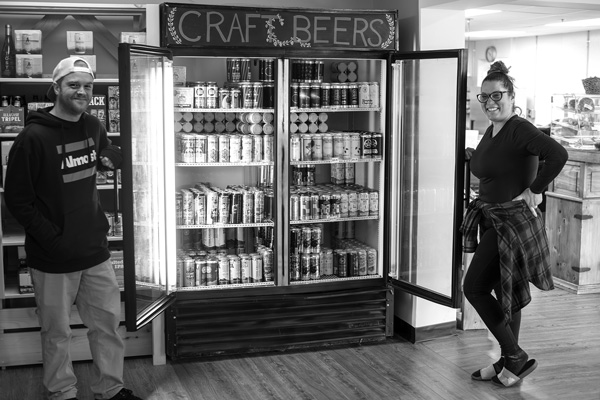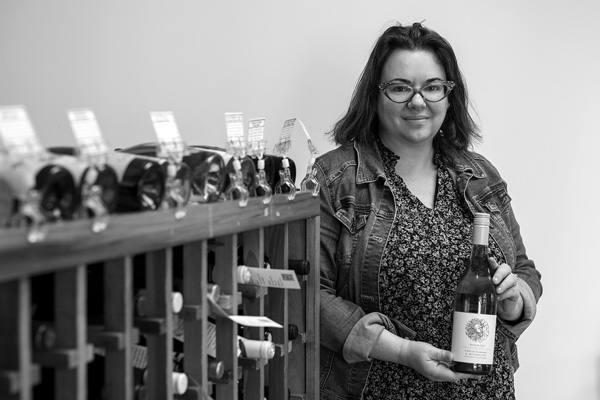News & Issues May 2023
Creating a downtown food hub
Nonprofit market aims to nourish Bennington’s ‘food desert’

Head baker Shayne Williams holds a tray of freshly baked loaves of bread at the new Bennington Community Market. Joan K. Lentini photo
By JOHN TOWNES
Contributing writer
BENNINGTON, Vt.
A new nonprofit market in downtown Bennington aims to bring fresh, healthy food to a town center that has long been classified as a food desert.
The Bennington Community Market, which opened in March at 239 Main St., says its mission is to “support local farmers, increase access to healthy food for all members of our community, and contribute to the revitalization of downtown Bennington.”
The new market sells fresh produce, dairy products, beer and wine along with a range of grocery staples and specialty items. It also offers take-home prepared meals and grab-and-go options prepared in its kitchen, and it has a 25-seat cafe for on-site dining. And its organizers want it to serve as a community gathering spot and a venue for educational and social events such as cooking classes and demonstrations by guest chefs.
The new store is designed to fill a need that local community leaders began discussing at least a decade ago after the U.S. Department of Agriculture designated Bennington as a “food desert.” The classification means the area has at least 100 households without vehicles that are more than a half-mile from the nearest full-service supermarket.
Although Bennington has Price Chopper and Hannaford supermarkets as well as a Walmart with a large grocery department, all of those stores are in a suburban commercial area that’s 2 to 4 miles from the town center. Reaching them can be a hardship for seniors, people with low incomes and others who can’t drive or don’t own cars.
In addition to those who don’t drive, the nonprofit market also hopes to cater to a group of new residents who are being drawn to the center of Bennington through a major downtown revitalization effort. That project, which started construction in 2019, is creating dozens of new apartments in the block just to the east of the new market and promises to greatly expand the population of the town’s pedestrian-oriented core.

Retail manager Riley Flynn, left, and general manager Diana Shepherd show off the selection of craft beer at the new Bennington Community Market. Joan K. Lentini photo
Local foods, equal access
The Bennington Community Market is open from 8 a.m. to 6 p.m. daily. Its inventory and operations are oriented toward meeting the goals of its social and economic mission.
“We emphasize food from many different regional farmers and producers,” said Diana Shepherd, the market’s general manager. “It’s similar to what you’d find at a farmers market, but we’re open seven days a week.”
The market offers some items from farther afield as well.
“Because we want to provide a variety of staples and essentials, we also carry products that aren’t available from local sources,” Shepherd explained.
Although natural and locally grown foods can be costlier than the fare available at commercial-scale supermarkets, the community market has cultivated partnerships with local organizations and social-service programs to address the problem of food insecurity. It aims to be welcoming to all and to make healthy food available and financially accessible to people with lower incomes.
The new market accepts benefit-card payments from the Supplemental Nutritional Assistance Program, or SNAP, and plans to be able to serve the Women, Infants and Children or WIC program as well.
It also strives to keep its prices as low as possible, such as by working with local producers to market and sell at a discount the produce they don’t sell at farmers markets.
The nonprofit group that runs the market also has established a Fresh Food Access Fund and has earmarked $5,000 for the ongoing program, which allocates gift coupons to Greater Bennington Community Services, Support and Services at Home, Sunrise Family Center, and Project Against Violent Encounters. These organizations distribute the coupons to clients experiencing food insecurity.
The access fund is supported with 15 percent of the market’s membership fees and through donations, including the opportunity for shoppers to round up their purchases to the next dollar. (The market sells $50 annual memberships for those who wish to support its efforts, although it is open equally to members and non-members.)
Shepherd described another strategy through which it aims both to reduce waste and make meals accessible.
“We sell grab-and-go hot prepared meals,” she said. “However, due to regulations, people cannot use SNAP to purchase hot meals. So the ingredients of hot meals that are unsold are used to prepare cold grab-and- go items the next day, which can be purchased with SNAP. Anything left from that is donated to a food bank.”
Shepherd said the initial response to the market has been positive.
“It’s become very popular, and people are very enthusiastic,” she said.
She credited Assistant Manager Riley Flynn and other staff members for its initial successes.
“We have an amazing team,” she said.
Community effort
The new market is a collaborative project set up by area residents with support from Bennington College, the town of Bennington, Southern Vermont Health Center and numerous other organizations. It is owned and managed by a nonprofit organization and board.
Money for its startup costs of about $550,000 has been raised from individual donations and memberships as well as from grants and other sources.
The market reflects larger ongoing efforts by a variety of organizations and advocates to strengthen the regional food economy, improve overall access to healthy and local foods, and reduce food insecurity in Bennington County.
Although the downtown area does have some smaller stores that offer grocery items, including the Spice ‘n Nice natural foods shop, several neighborhood corner stores and a Dollar General, the range of food products available in the town center has been limited. The USDA’s “food desert” designation means a significant population has lacked access to significant nearby sources of vegetables, whole grains, milk or dairy alternatives and other foods that make up the full range of a healthy diet.
“People had been talking about the need for a market like this in the center of town for many years, but earlier efforts to start one had not been successful,” said Shannon Barsotti, the town’s director of community development. “More recently, due to a combination of circumstances, it came to the top of the list.”
One stimulus for the market was an initiative by the Center for the Advancement of Public Action at Bennington College, a program through which students and faculty aim to support local initiatives for positive social change.
In 2019, the center was awarded a $1 million grant from the Andrew W. Mellon Foundation to address the systemic causes of food insecurity in Bennington County, where studies indicate 14 percent of the population is low income and many households are a significant distance from supermarkets.
The three-year grant is set up as a partnership between the center, Southwestern Vermont Health Care, the Southwest Vermont Supervisory Union, and Greater Bennington Interfaith Community Services.
The process of implementing the grant included the formation of working groups to evaluate the local food system and develop strategies. It also includes a Community Resource Fund, which has allocated grants to food pantries, producers, educational programs and other organizations involved in projects related to food security.
The effort to start a community market is one of the initiatives that received support from this, including a grant for research and outreach to local organizations and producers to develop partnerships and plans.
Reviving a downtown
Another factor that has helped to make the market a reality is the major downtown revitalization effort known as the Putnam Block project. This ambitious public-private partnership includes the restoration of three historic multi-story buildings at the “four corners” intersection in the center of downtown as well as plans for construction of several new commercial and residential buildings on adjacent sites.
The Putnam Block project is being built and opened in phases. In addition to renovated commercial spaces, the project is creating new living spaces in the long-vacant upper floors of downtown buildings.
Barsotti said the town and the other agencies and organizations have supported the creation of the community market because it fits in with the goals of revitalization in several ways.
“It adds to the vitality and diversity of downtown Bennington,” she explained. “Also the additional residents moving to the town center will expand its customer base.”
The town provided the market with a $200,000 low-interest loan from the Bennington Revolving Loan Fund. The project also has received economic development grants from the Citizens for Greater Bennington, The Vermont Community Foundation, and the state’s Building Communities program.
But a majority of the cost has been raised through a fund drive and memberships.
The market is located in a 15,000-square-foot building that had previously been a furniture store. It has three sections that are about 5,000 square feet each. The store and cafe and community space occupy the front portion. The middle section includes a kitchen and storage area. The back section is currently unused, but there are plans to have a fitness center occupy that area as a tenant.
Converting the space into a market required extensive work. The original goal was to open in early 2022. But that timetable was extended because of economic conditions and supply shortages resulting from the Covid-19 pandemic.
The market has a staff of about 20 people. It is managed by Shepherd, who is from Florida and worked in hospitality and food service management there. Shepherd joined the project in 2021 and was heavily involved in its preparation and design.
“I came up for a vacation after leaving my job in Florida, and it turned out to be a one-way trip,” she said. “I met the people who were organizing the market and was invited to interview for the manager position. I was enthusiastic about what they were doing, and it went from there.”
The market also sells specialty beer and wine. Nancy Koziol, owner of couch + cork, a local business that conducts wine tastings in homes and at other sites, serves as the market’s wine steward. She selects the wines and is regularly at the market to help customers.

Nancy Koziol, owner of the local business couch + cork, serves as the wine steward at the new Bennington Community Market. She selects the market’s stock of wine and hosts tastings and other events at the store. Joan K. Lentini photo
“My business is unique in not having a brick-and-mortar location,” Koziol said. “Our goal is to educate people about wine and make the enjoyment of wine accessible. Rather than simply having a wine section, the market invited me to bring the services of couch + cork into the store to help people match the food they purchase with wine.”
She also offers tastings and other events in the store.
“I love it because it is a chance to do this on a community level, and people enjoy it because it’s personalized and fun,” Koziol said.
That arrangement is an example of the potential for the market to stimulate other forms of entrepreneurship, Barsotti said.
“It can provide an outlet and incubator space for new local food ventures,” she said.
